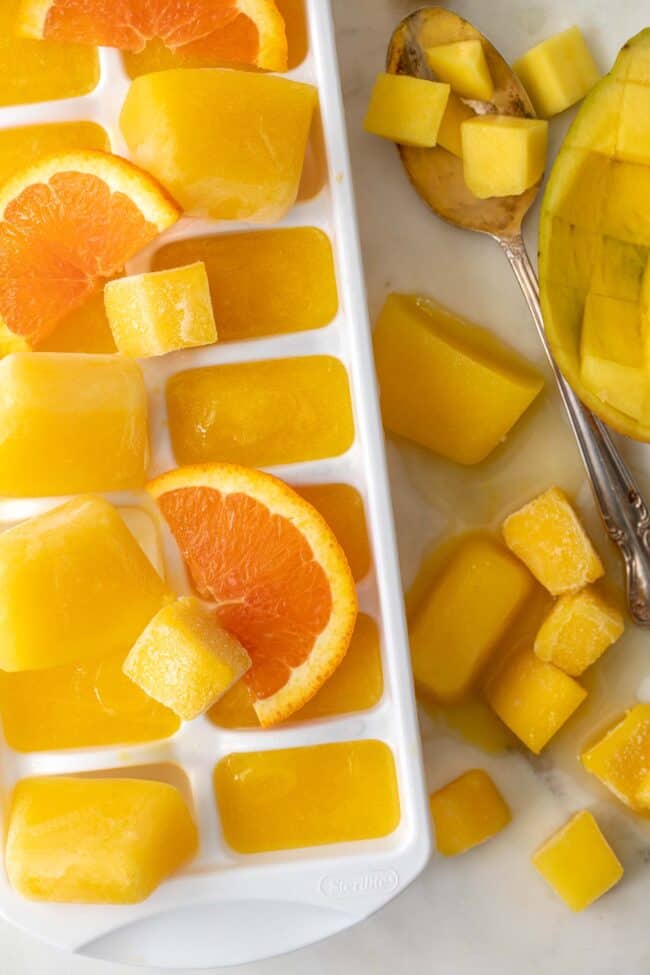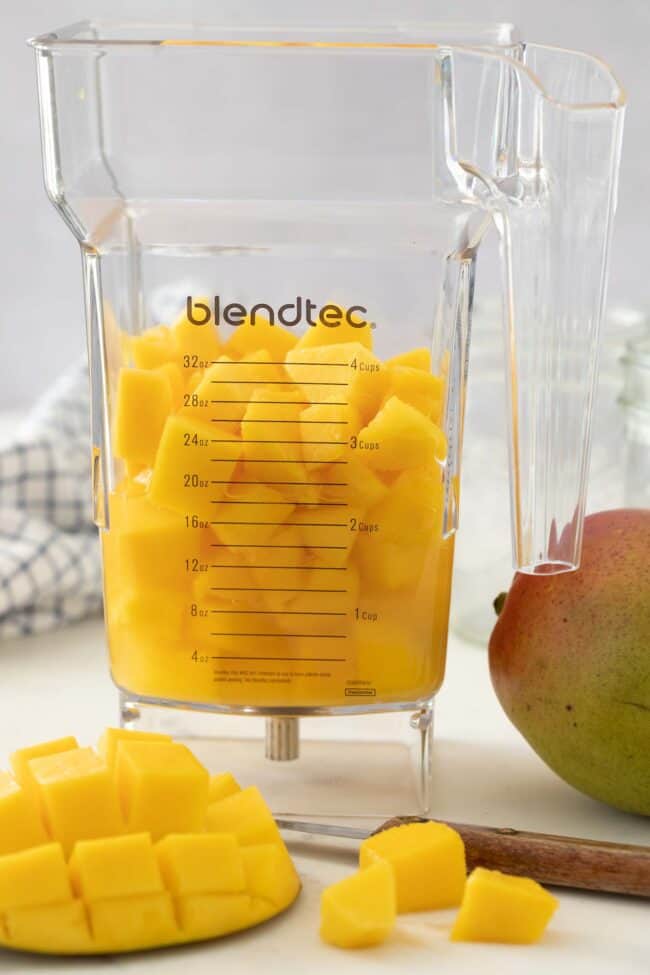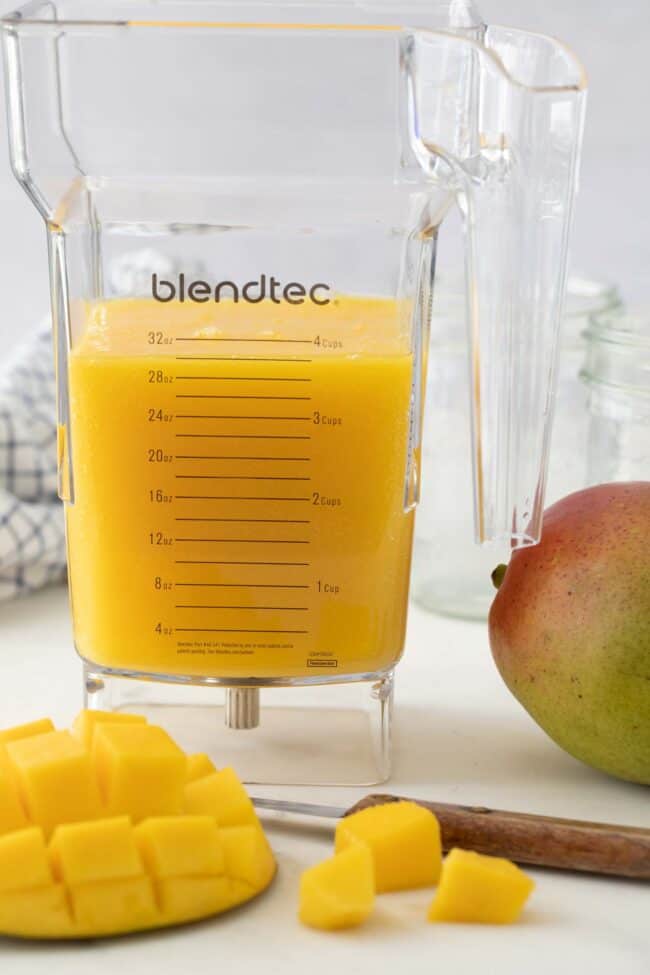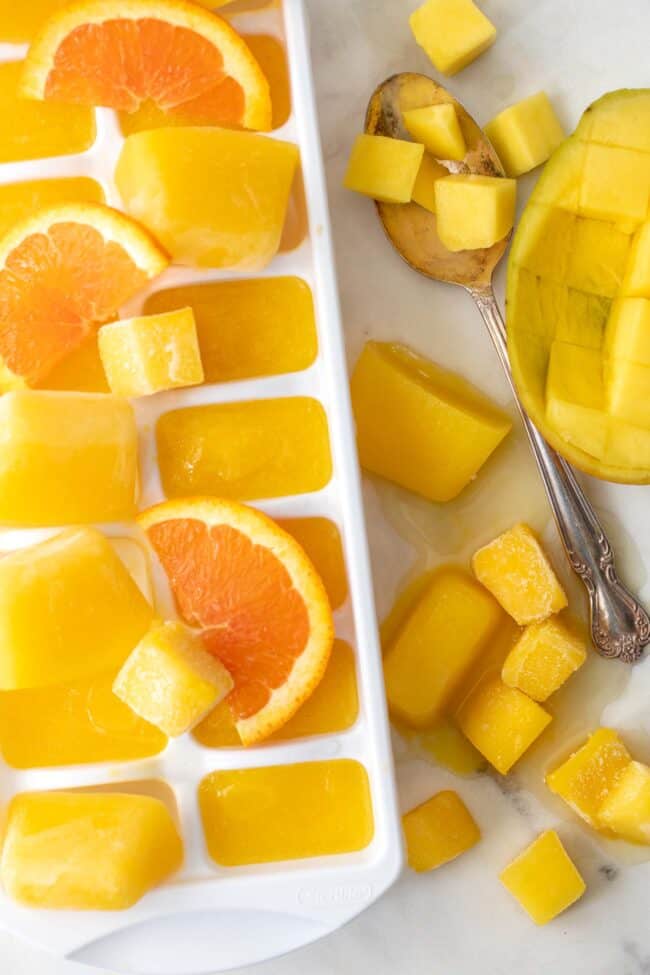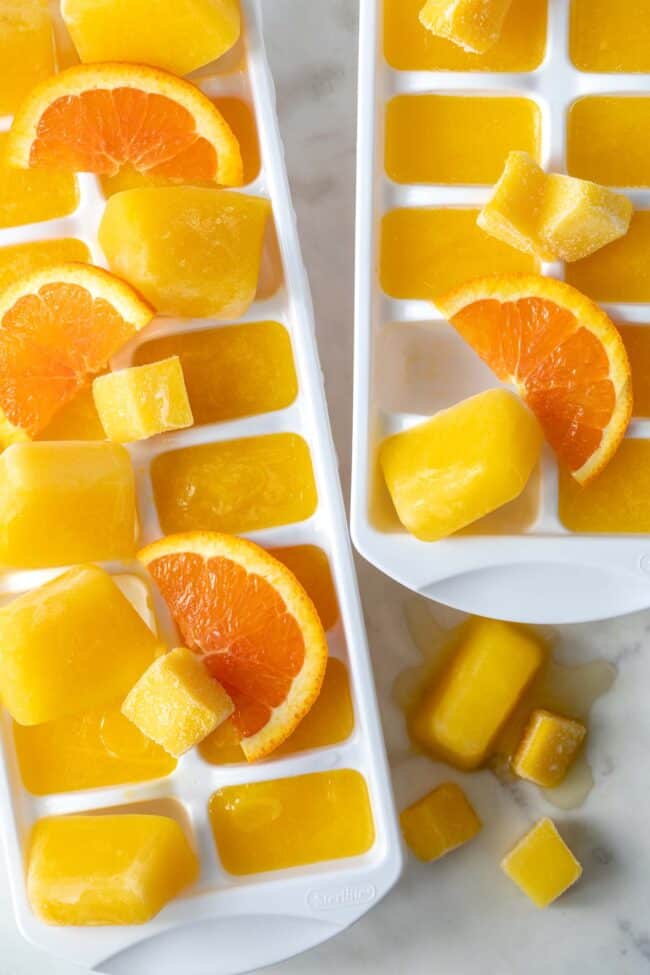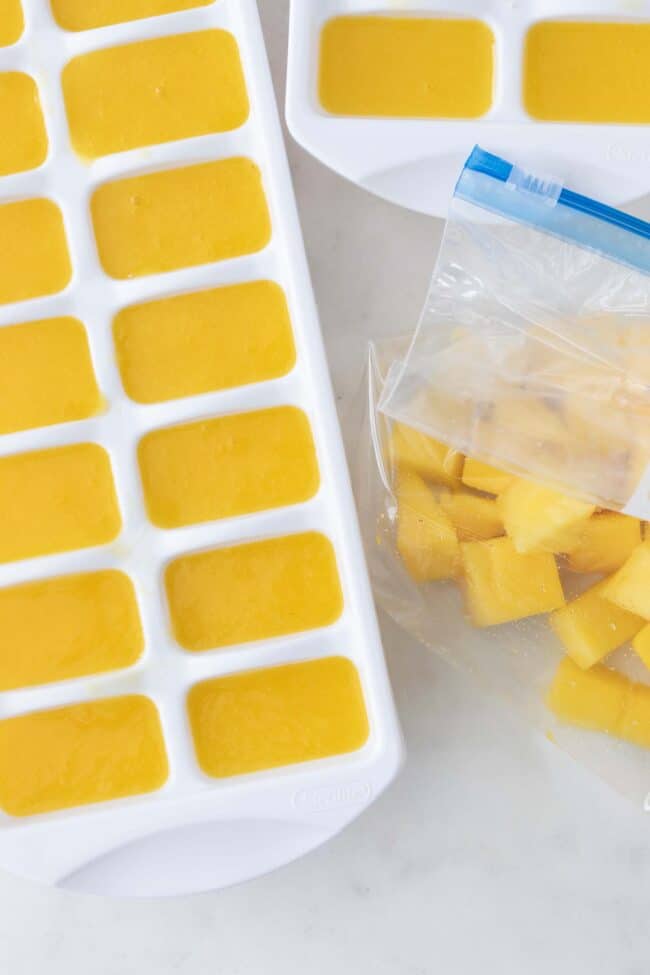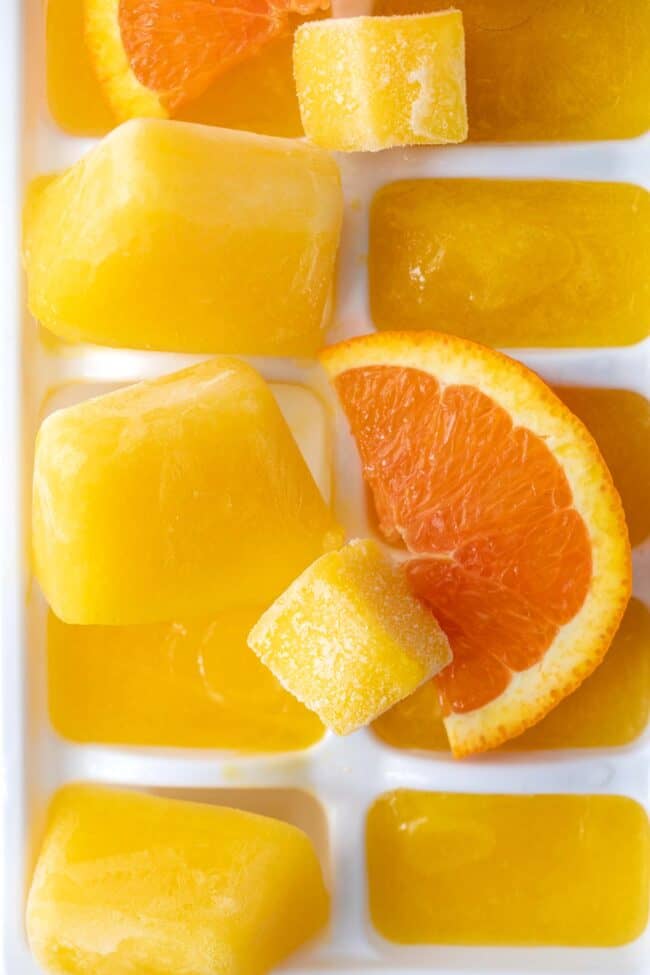Mango Nectar Juice Cubes
Mango is often referred to as ‘king of fruits” and for good reason. This Mango Nectar Juice Cubes recipe is quick and easy to make and the frozen mango juice cubes are great to have on hand to add to water, smoothies and juice blends.
The flavor of mango is matchless. Just one bite out of the juicy orange flesh of a mango should make a fan out of anyone.
I love to have these Mango Nectar Ice Cubes stashed in the freezer, especially when I don’t have any fresh mango on hand. If you’re not new to THK, you know I love flavored ice cubes to add to water, tea, juices and smoothies. I especially love to add them to a glass of water for the added flavor and nutrients. It helps me drink more water during the day. If you like mango, you’ll love these Mango Nectar Ice Cubes!
Mango Nectar Ice Cubes Recipe
You want to use fresh mango for this recipe because it has a much richer and sweeter flavor than frozen mango. You can also add 1/4 cup of fresh squeezed orange juice or pineapple juice to the mix for added flavor and nutrients.
- Mango. We use 2 large mangoes, peeled and chopped
- Water. A little water helps to blend and liquify the mango
Find printable recipe with measurements below.
How To Make Frozen Mango Juice Cubes
Mangoes don’t make a very good candidate to juice in a juicer. The flesh is too soft with stringy fiber. Mango nectar juice is a little thicker than most fruit juices, but adding water helps to liquify it.
- Cut Mango. Slice the fresh ripe mango flat side down along the seed. Make slices along the flesh. Using a spoon, scoop the flesh away from the peel.
- Blend. Add the mango pieces, water and orange juice to the blender, and blend on high for 15-20 seconds until the juice is smooth. If your juice still has a lot of fiber left after blending, you can strain it through a fine colander or strainer. You can also add a little more water for a thinner consistency.
- Serve. Pour over ice. Enjoy!
When are Mangoes in Season
That depends on where you live. In the United States, mangoes have the longest season in Hawaii from March through November. In California, Mangoes are in season June through August, and in Florida from May to August. However, with imported mangoes coming from Mexico, South America and Asia, you’ll often be able to find mangoes in the markets all year long.
How to Tell When a Mango is Ripe
A perfectly ripe mango will have a strong flowery fragrance at its stem end, and will slightly yield when you gently squeeze it. The skin should have tones of yellow-orange or red which will increase as the fruit ripens. Avoid mangoes that have a loose or shriveled skin, or black spots on the skin which may indicate overripeness and damage to the flesh inside.
How to Cut a Mango
Cutting a mango can be a bit tricky at first, but once you get the hang of it, it’ll become a breeze.
- Hold the fruit standing on one of its ends.
- Slice down one side of the pit vertically, then repeat on the other side. There will be flesh left around the pit.
- Using a paring knife, score the flesh of each half into cubes. You don’t want to slice all the way through the skin.
- Using a spoon, scoop along the inside of each half as close to the skin as you can to cut out all of the cubes. Alternately, you can turn each half inside out so the cubes pop outward, then cut away the cubes,
- Cut away the band of fruit around the pit and peel away the skin. Cut the flesh into pieces.
More Flavored Ice Cubes
- Pomegranate Elderberry Ice Cubes
- Smoothie Cubes
- Immune Boosting Whole Lemon Ice Cubes
- Hydrating Lemon Cucumber Ice Cubes
- Cold Fighting Citrus Ice Cubes
- Anti Inflammatory Ginger Ice Cubes
- Summer Berry Ice Cubes
Looking for More Mango Recipes
- Mango Juice
- Mango Dragonfruit Refresher
- Mango Arugula Quinoa Salad
- Mango Slaw
- Mango Salsa
- Curried Mango Chicken Salad
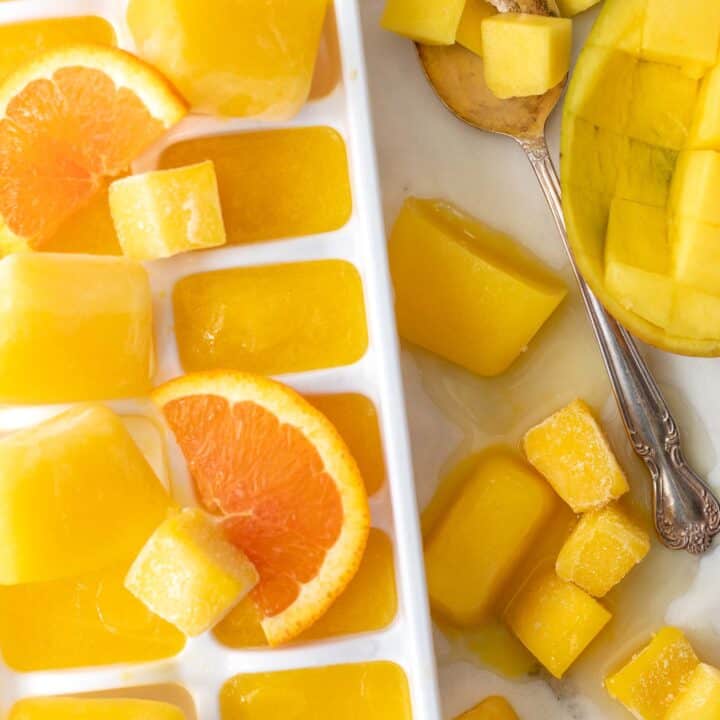
Mango Nectar Juice Cubes
Mango is often referred to as 'king of fruits" and for good reason. These immune-boosting Mango Nectar Juice Cubes are rich with vitamins, minerals, antioxidants and anti-inflammatory properties. It's great to have a stash of mango juice cubes on hand when it's not mango season to add to water, smoothies and juice blends.
Ingredients
- 2 cups mango (about 2 large mangoes)
- 2 cups water
- 1/4 cup fresh squeezed orange juice (optional)
Instructions
- Slice the mango flat side down along the seed. Make slices along the flesh. Using a spoon, scoop the flesh away from the peel.
- Add the mango pieces to a blender.
- Pour in the water (and orange juice if adding) into the blender with the mango. Blend on high for 15-20 seconds until the juice is smooth.
- Using a funnel pour the mango nectar into the ice cube trays.
- Freeze for 8 hours or overnight. Remove the mango nectar juice cubes from the ice cube trays and place in a freezer bag to store in the freezer.
- Serve in water, add to smoothies, crush the cubes in a blender to eat as slushed ice.
Notes
How to Cut a Mango
Cutting a mango can be a bit tricky at first, but once you get the hang of it, it'll become a breeze.
- Hold the fruit standing on one of its ends.
- Slice down one side of the pit vertically, then repeat on the other side. There will be flesh left around the pit.
- Using a paring knife, score the flesh of each half into cubes. You don't want to slice all the way through the skin.
- Using a spoon, scoop along the inside of each half as close to the skin as you can to cut out all of the cubes. Alternately, you can turn each half inside out so the cubes pop outward, then cut away the cubes,
- Cut away the band of fruit around the pit and peel away the skin. Cut the flesh into pieces.
Nutrition Information:
Yield:
6Serving Size:
1Amount Per Serving: Calories: 38Total Fat: 0gSaturated Fat: 0gTrans Fat: 0gUnsaturated Fat: 0gCholesterol: 0mgSodium: 4mgCarbohydrates: 9gFiber: 1gSugar: 8gProtein: 1g
theharvestkitchen.com attempts to provide accurate information, however, this nutritional information is provided as a courtesy and is an estimate only. The nutritional information provided comes from online sources and calculations. See full disclaimer on About page.
